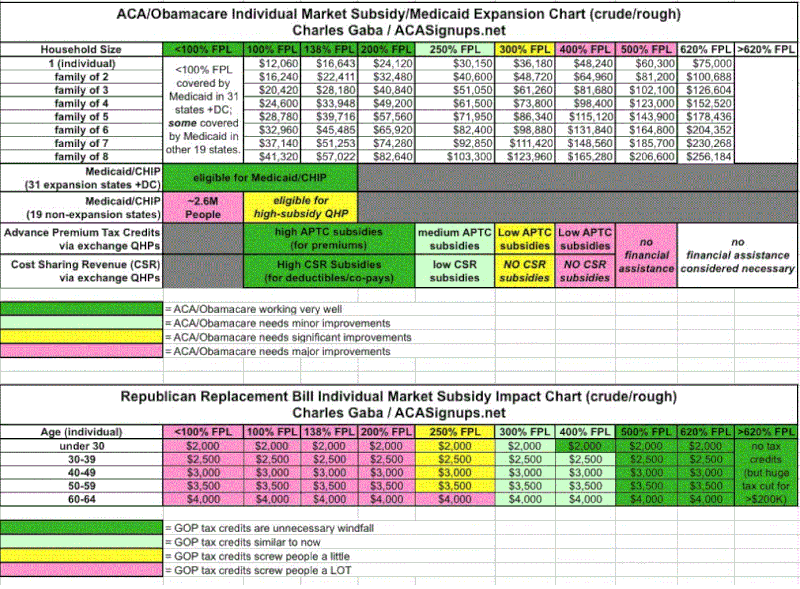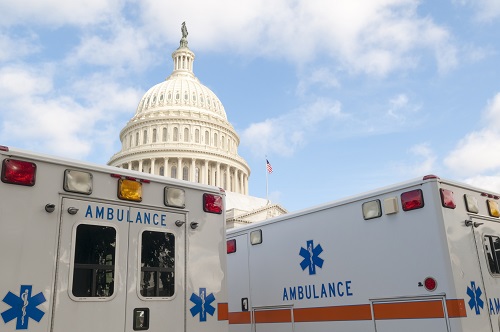The House released its replacement to Obamacare.
A couple of things to note:
1. There is a 30% surcharge if you go 63 days in the previous year without insurance. This is the alternative to the mandate – and basically you could if you are young go years without insurance and then just pay the surcharge when you are sick.
But if you lose your job, and the COBRA cost is through the roof, you may wind up getting locked out of the system.
2. The rating for insurance is gone – so be prepared for the return of junk insurance.
Which the GOP will claim is cheaper.
3. This is an attack on Medicaid plain and simple.
I am sorry to distract some readers from the latest Russian news with data about the House replacement for Obamacare.
So some more information – I will probably just keep adding stuff
The subsidy table courtesy of Charles Gaba. There are two significant changes to note. The subsidy in the house bill is flat, and it varies by age. The flat subsidy is of course a windfall for anyone in the upper half of income. The other is that the subsidies are much lower than was the case under Obamacare.

What about the cost?
Well the House doesn’t care. They are moving forward without a markup. There are two reasons for this:
1. The House Bill repeals all but the Cadillac portion of the Obamacare tax increases. This means that it will explode the deficit unless it relies on drastic Medicaid cuts.
2. Avik Roy, a conservative, suggests the House bill will cover about 20 million fewer Americans.
Charles Gaba has a diary at DKOS – I encourage everyoone to visit.
One of the real questions here is what can be done via reconciliation and what can’t. Here is his list of what needs 60 votes:
- Guaranteed issue (no pre-existing condition denials)
- Community rating (can’t charge different people more for the same policy outside of a tight set of parameters)
- The ACA’s preventative benefits (I’m not sure if this list changes, but I’d imagine not)
No lifetime or annual limits on coverage (a few people have stated otherwise, but this seems to be the consensus) - Required essential benefits for every plan on the private market (ie, group or individual)
Limits on out-of-pocket costs for enrollees - Young adults 19-25 being allowed to stay on their parents’ plan (I’ve noted before that I always suspected this would survive any repeal effort)
- “Removing the lines” to allow carriers to “sell insurance across state lines” (at least not any more so than the ACA already allows them to)
The “Grassley Amendment”: Congressional staffers will still have to enroll via the DC exchange in order to receive tax credits. - The 80/20 Medical Loss Ratio (requires insurance carriers to refund the difference to enrollees if they spend more than 20% of premium costs on anything other than actual, legitimate medical care)
Ryan Lizza in the a href=”http://www.newyorker.com/news/ryan-lizza/paul-ryans-health-care-vise”> New Yorker with as good a take as I have seen ont he politics:
Forced to navigate House Republican politics, the lobbying pressure from the insurance industry, and the obscure rules of the budgeting process, Ryan has produced a bill that nobody would ever propose as a sane solution to the problems with Obamacare. Its only chance is speed. If Ryan can rush and muscle it through the House and Mitch McConnell can do the same in the Senate, it might end up on Trump’s desk. But the more scrutiny this House bill is subjected to, the more likely it is to share the fate of most efforts at health-care reform and die somewhere on its journey to the Senate, and perhaps long before then. If his health-care-reform effort fails, Ryan himself may not survive as the House leader. Meadows and his colleagues catapulted Ryan to the Speakership, and they still have the power to bring him down.







